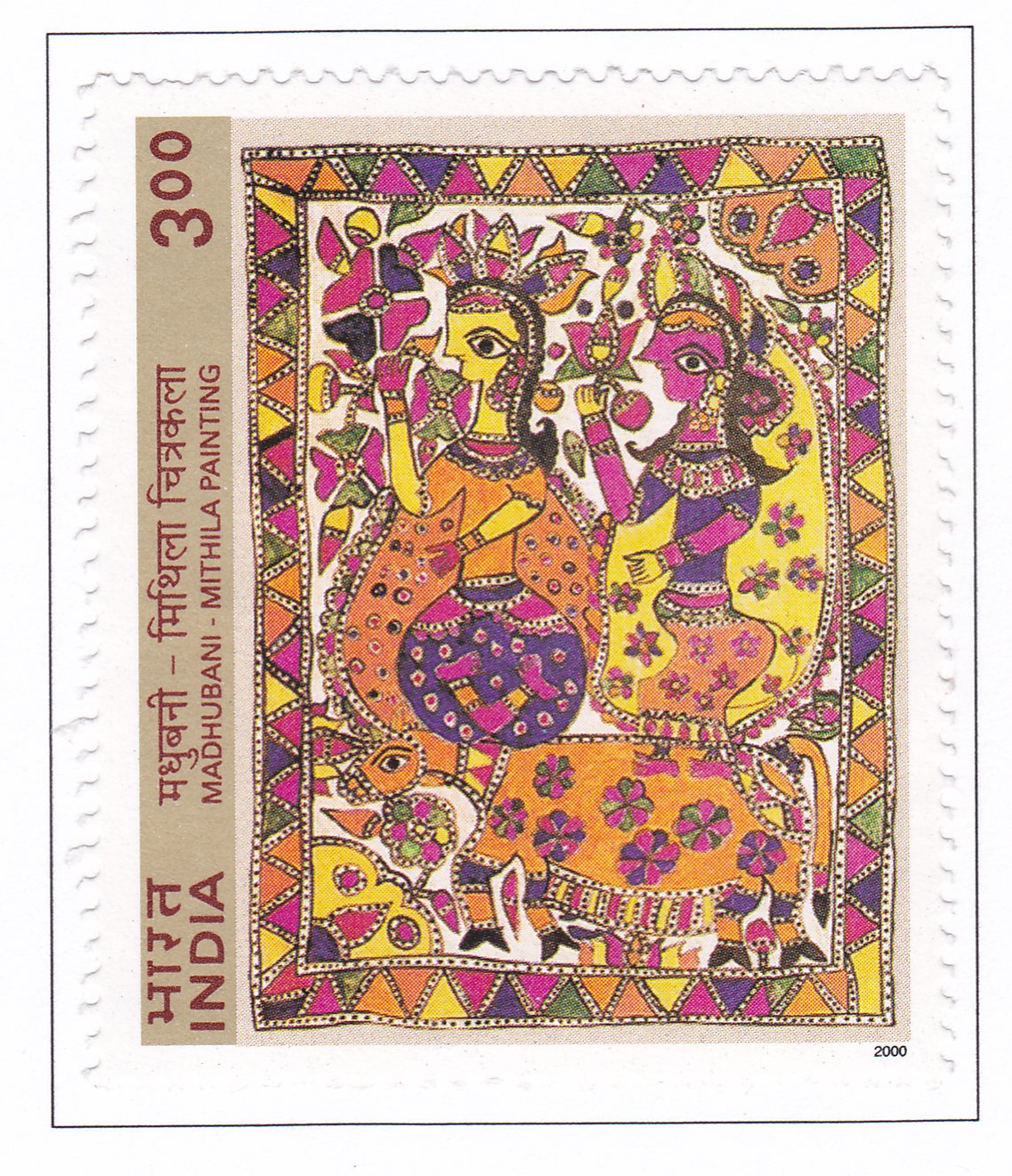“Flower Girls” (Nirmala Devi)

Technical Data
| Stamp Set | Madhubani Mithila Paintings |
|---|---|
| Date of Issue | October 15, 2000 |
| Denomination | Rs. 3 |
| Quantity | 3,000,000 |
| Perforation | comb 13½ |
| Printer | Calcutta Security Printers Ltd |
| Watermark | No Watermark |
| Colors | Multicolor |
| Catalog Codes |
Michel IN 1787 Stamp Number IN 1851 Yvert et Tellier IN 1553 Stanley Gibbons IN 1956 |
| Themes | Art | Paintings |
Table of Contents
Commemorative Stamp Set: “Flower Girls” (Nirmala Devi)
Design Elements:
- Floral Theme: The stamp design showcases women carrying flowers, symbolizing purity, beauty, and femininity. The figures are gracefully depicted with stylized floral motifs.
- Madhubani Art Style: The artwork is characterized by fine lines, vibrant natural colors, and intricate patterns, typical of Madhubani painting.
- Traditional Motifs: Surrounding the flower girls are various geometric and natural elements such as leaves, flowers, and decorative borders, emphasizing the cultural context of nature and rural life.
Cultural and Historical Significance:
- Representation of Rural Life: The painting reflects daily life in Mithila, where women often engage in rituals and customs involving flowers, symbolizing abundance and devotion.
- Feminine Role in Madhubani Art: The focus on women in traditional art highlights the key role they played as creators of these paintings, continuing the age-old practice of expressing social and religious stories through art.
- Art of Rituals: Historically, Madhubani art was created on special occasions like weddings and festivals, making the “Flower Girls” theme a celebration of both cultural and ritualistic significance in rural Bihar.
Usage:
- Commemorative: This stamp serves as a tribute to the Madhubani art tradition and to the women who have perpetuated this cultural practice for centuries.
- Cultural Promotion: By using this artwork on stamps, the postal department is promoting India’s folk art heritage globally.
- Philatelic Value: A collector’s item for those interested in folk art, Indian culture, and mythological themes, as well as for general philatelists.
Importance of the Commemorative Stamp Set:
- Promotion of Indigenous Art: This stamp set plays a crucial role in bringing lesser-known folk art forms like Madhubani into mainstream recognition, preserving these traditions for future generations.
- Representation of Women in Art: “Flower Girls” symbolizes the contribution of women artists in preserving cultural heritage and fostering artistic expressions of rural traditions.
- Cultural Identity: The stamp strengthens the connection between India’s cultural identity and its artistic heritage, especially through folk art forms like Madhubani.
Example of the Stamp Design:
- The stamp features two or more women, depicted as flower girls, elegantly drawn with intricate detailing in their attire, carrying stylized floral baskets. Bright colors, derived from natural sources, are used to depict their vibrant traditional attire, flowers, and surrounding flora, adding to the richness of the Madhubani style. The background consists of geometric patterns, representing the rhythmic and decorative elements of the art.
The Commemorative Stamp Set Might Include:
- Other Rural Themes: Alongside “Flower Girls,” the set could include more Madhubani paintings portraying rural life, mythological stories, or religious rituals, all painted by various women artists from the region.
Significance:
This commemorative stamp set highlights the artistic excellence and cultural importance of Madhubani painting, with “Flower Girls” representing the everyday life and feminine grace of rural India. Through this artistic representation, the stamp set serves as a cultural ambassador, promoting India’s folk art on a national and international scale.
